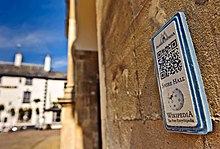User:John Cummings/Archive/blogfortalk
Wikipedia's relationship with open source hardware. (explained through the medium of Star Trek)

I’m interested in how information relates to the physical world, and how Wikipedia and other open projects can aid people’s understanding of the world around them. The project I have been involved with MonmouthpediA and GibraltarpediA are attempts to connect people with information about the things around them in their own language using QRpedia codes, a type of bar code a smartphone can read through its camera (using one of the many free QR readers available) that takes you to a Wikipedia article in your language. QR codes are extremely useful, as physical signs have no way of displaying the same amount of information and in a potentially huge number of languages. I see this as a rudimentary Star Trek Tricorder and Universal translator.
I’m not a programmer or an engineer, I like to fiddle with things and see what they can do. I think 3D modelling including photogrammetry and low cost 3D printing could potentially vastly improve our understanding of our environment in many different ways.
By combining 3d printing and photogrammetry I can see in it the beginnings of a Star Trek Replicator :)
Photogrammetry[edit]
A process of taking several photographs of an object or environment and generating a 3d model of the object, there are two sorts of 3d model that can be created, wire-frame models and Point clouds.
-
Gibraltar 1 Neandertal skull, 3d model, created with 123d Catch.
-
Monmouth Castle point cloud, created with Photosynth
-
The point cloud seen from above, no photos were taken from this angle
I think of this as the equivalent of a pop up book, allowing people to potentially understand environments and objects in new ways, museums and other institutions of all sizes could create better documentation of their collection for basically free and offer a more rich way of viewing objects not on display.
3D printing[edit]
explosion in online learning platforms with excellent content
offer academic understanding on many different subjects
- Museums can offer replicas of objects to visitors, allowing the to explore objects
learning styles
in schools, producing teaching aids from already available 3d models
mail order 3d models
3D printing is the process of creating a 3d object from a computer file, usually through an additive process, like a cross between a normal printer and geological deposition.
There are many 3D printers
Reprap 3d printer, a project at Bath University with the aim of creating a self replicating machine, at the moment the 3d printer that is able to replicate around 50% of it’s self. Currently around £500 may reduce very quickly
Reprap has a community, in many ways similar to the Wikipedia community
Learning through making
create better parts which can be printed on the printer they are to be installed on, allowing you to download hardware updates
a person
http://www.omote3d.com/product/index.html
crowd funded project to create 3d printers http://www.kickstarter.com/projects/formlabs/form-1-an-affordable-professional-3d-printer
Extremely cheap manufacturing
potential for using Wikipedia as a repository for 3d models
A huge array of applications:
- Researchers at duPont Hospital for Children in Wilmington, Delware created a custom exoskeleton for a young girl with Arthrogryposis
Should commons hold 3d models potentially dangerous objects like a knife or a gun (something that is starting to happen now)?
I think 3d printing with open source models has quite large implications for society, harnessing people's creativity in new ways and potentially disruptive to current economic models based on scarcity of resources based and the production capability of the individual, including people being able to chose to make objects in biodegradable materials.
NASA and the US army are already trialing it.
produce human cartilage replacement
very cheap printing of educational models could be used by schools and individuals
anatomic human foot, mouse skull (from micro CT scan), a printable vacuum pump , RNA Polymerase, Automatic Transmission Model
The first examples of people creating their own 3d printed prosthetics are starting to happen [http://www.ted.com/talks/tal_golesworthy_how_i_repaired_my_own_heart.html%20 high
There are many open source design projects that use collaborative testing and designing to improve upon previous iterations and solve problems in new ways including cleaning up oil spills.
This is the 24th century, material needs no longer exist....the challenge is to improve yourself, to enrich yourself, enjoy. ~ Jean-Luc Picard


